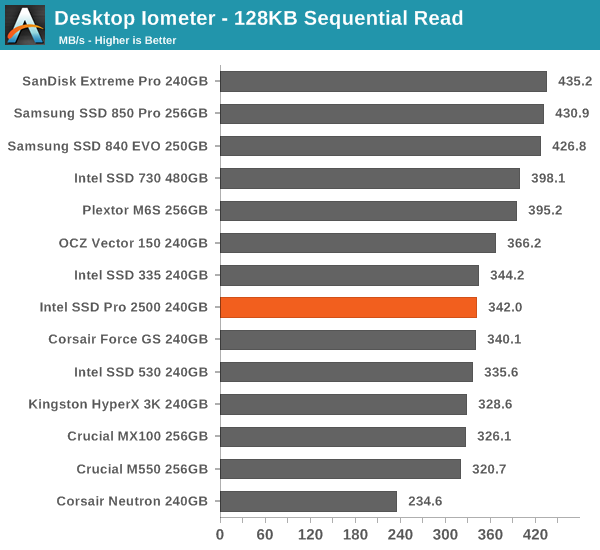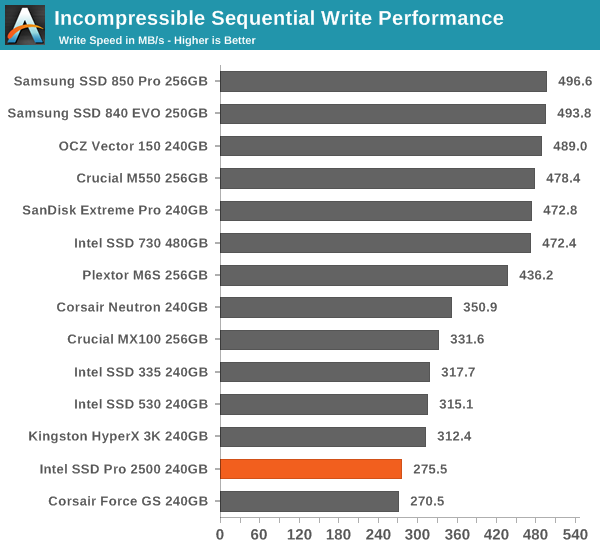Intel SSD Pro 2500 (240GB) Review
by Kristian Vättö on July 30, 2014 5:00 AM ESTRandom Read/Write Speed
The four corners of SSD performance are as follows: random read, random write, sequential read and sequential write speed. Random accesses are generally small in size, while sequential accesses tend to be larger and thus we have the four Iometer tests we use in all of our reviews.
Our first test writes 4KB in a completely random pattern over an 8GB space of the drive to simulate the sort of random access that you'd see on an OS drive (even this is more stressful than a normal desktop user would see). We perform three concurrent IOs and run the test for 3 minutes. The results reported are in average MB/s over the entire time.



Random performance is quite typical (and unsurprising) for SandForce. Once again the performance drops when switching to incompressible data, although at low queue depths the write performance is still relatively good despite the drop.
Sequential Read/Write Speed
To measure sequential performance we run a 1 minute long 128KB sequential test over the entire span of the drive at a queue depth of 1. The results reported are in average MB/s over the entire test length.

No surprises in sequential peformance either.

AS-SSD Incompressible Sequential Read/Write Performance
The AS-SSD sequential benchmark uses incompressible data for all of its transfers. The result is a pretty big reduction in sequential write speed on SandForce based controllers.












42 Comments
View All Comments
Impulses - Wednesday, July 30, 2014 - link
I don't think they ever intended to be a major player in the consumer side, low margins and all that, they jumped in to kickstart the market while other OEM couldn't get out of their own way.FunBunny2 - Wednesday, July 30, 2014 - link
Given that Enterprise SSD was the province of small vendors and RAM SSDs for more than a decade before NAND versions began to be built, Intel really has never had an Enterprise presence in SSD. That they make half-hearted attempts, using third-party controllers no less, means they won't be taken seriously. IBM could have bought their SSD shop, but took Texas Memory instead. There's a lesson in that.Kristian Vättö - Wednesday, July 30, 2014 - link
Saying that Intel has no enterprise SSD presence is just nuts. Last year Intel was the #1 enterprise SSD vendor in terms of revenue.http://regmedia.co.uk/2014/06/13/gartner_ww_ent_ss...
http://regmedia.co.uk/2014/06/13/gartner_ssa_revs_...
IBM's SSA revenue is not even close, let alone the fact that the array market is not the same thing as the enterprise SSD market. Many SSA vendors use drives from the enterprise SSD vendors.
FunBunny2 - Thursday, July 31, 2014 - link
Just because Intel/whoever shifts lots o SATA drek to ABC Corp. to fill up desktops and the occasional windoze/*nix document server doesn't make Intel/whoever an Enterprise Storage player.Enterprise Storage means:
fibre channel
serial attached SCSI
InfiniBand
"The first terabyte class FC SSD systems started shipping in February 2003."
Here: http://www.storagesearch.com/ssd-fc.html
You should spend some quality time with Zolt. You'll learn a lot about SSD.
kaix2 - Thursday, July 31, 2014 - link
what a funny bunny. intel focuses more on enterprise ssd and is the #1 vendor in that space. the 3rd part controllers are for low margin consumer drives.mikk - Wednesday, July 30, 2014 - link
Crucial and Samsung are much more interesting for client SSD users nowadays, Intel is more or less dead in this space.jeffrey - Wednesday, July 30, 2014 - link
Crucial more exciting than SanDisk in client SSD?? The value of the Extreme II and performance of the Extreme Pro are more interesting to me than anything Crucial has (price).hojnikb - Wednesday, July 30, 2014 - link
Have you looked at the Crucial prices recently ?They prety much destroy competition with price/GB.
emn13 - Wednesday, July 30, 2014 - link
Given the overall similarity of modern SSD performance in client workloads, price & reliability are the most important aspects (to me). It's not like even a fairly heavy workload will result in differences even a power user is likely to notice.mapesdhs - Wednesday, July 30, 2014 - link
Wow, are you really saying you'd opt for an MX100 instead of the Sandisk X210? Because
that would be a really weird decision (they're almost the same price here). The X210 is by
far the better product yet is only fractionally more.
Ian.